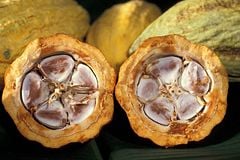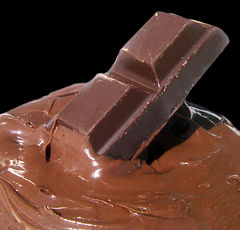Cocoa
Cocoa is the dried and partially fermented fatty seed of the cacao tree from which chocolate is made. In the United States, 'cocoa' often refers to cocoa powder, the dry powder made by grinding cocoa seeds and removing the cocoa butter from the dark, bitter cocoa solids. By itself it has an extremely bitter flavor.
A pod has a rough leathery rind about 3 cm thick (this varies with the origin of pod). It is filled with sweet, slimy pulp called 'bava de cacao' in South America, enclosing 30 to 50 large almond-like seeds (beans) that are fairly soft and pinkish or purplish in color.
Hot cocoa is often confused with hot chocolate, but hot cocoa is made from the cocoa solids, while true hot chocolate is made from whole chocolate.
History
The cacao tree apparently originated in the foothills of the Andes in the Amazon and Orinoco basins of South America. It was introduced into Central America by the ancient Mayas, and cultivated in Mexico by the Toltecs and later by the Aztecs.
Cocoa was an important commodity in Pre-Columbian Mesoamerica. Spanish chroniclers of the conquest of Mexico by Hernán Cortés relate that when Moctezuma II, emperor of the Aztecs, dined he took no other beverage than chocolate, served in a golden goblet and eaten with a golden spoon. Flavored with vanilla and spices, his chocolate was whipped into a froth that dissolved in the mouth. No less than 50 pitchers of it were prepared for the emperor each day, and 2000 more for nobles of his court.
Chocolate was introduced to Europe by the Spaniards and became a popular beverage by 1700. They also introduced the cacao tree into the West Indies and the Philippines. It was used in alchemical processes, where it was known as Black Bean.
The cacao plant was first given its name by Swedish natural scientist Carl von Linné (1707-1778), who called it "theobroma cacao" or "food of the gods".
World Production
In 2004 the world production of cocoa beans FAOSTAT (in tons) per country was assorted as follows;
- Côte d'Ivoire (Ivory Coast) - 1,331,494 t
- Ghana - 736,000 t
- Indonesia - 430,000 t
- Nigeria - 366,000 t
- Brazil - 169,416 t
- Cameroon - 130,000 t
- Ecuador - 88,000 t
About 3,000,000 tons of cocoa are grown each year. The global production was
- 1,556,484 t in 1974,
- 1,810,611 t in 1984,
- 2,672,173 t in 1994,
- 3,607,052 t in 2004 (record).
This is an increase of 99.2% in 30 years.
The pod itself is green when ready to harvest (rather than red or orange). Normally red or orange pods are considered lesser quality because their flavor and aroma are poorer; they are used for industrial chocolate.
The Netherlands is the leading cocoa processing country, followed by the U.S.
Prices for cocoa reached a five-year high in November 2004 because exports from Côte d'Ivoire (Ivory Coast) were likely to decrease due to escalating violence in the region.
Cocoa and its products (including chocolate) are used world-wide. Belgium has the highest per-capita consumption at 5.5 kg, 10 times the world average [1].
Harvesting
When the pods ripen, they are harvested from the trunks and branches of the Cocoa tree with a curved knife on a long pole. The pods are either opened on the field and the seeds extracted and carried to the fermentation area on the plantation, or the whole pods are taken to the fermentation area.
Processing
The harvested pods are opened with a machete, the pulp and cocao seeds are removed and the rind is discarded. The pulp and seeds are then piled in heaps, placed in bins, or laid out on grates for several days. During this time, the seeds and pulp undergo "sweating", where the thick pulp liquifies as it ferments. The fermented pulp trickles away, leaving cocao seeds behind to be collected. Sweating is important for the quality of the beans, which originally have a strong bitter taste. If sweating is overdone, the resulting cocao may be ruined; if underdone the cocao seed maintains a flavor similar to raw potatoes and becomes susceptible to mildew.
The liquified pulp is used by some cocoa producing countries to distill alcoholic spirits.
The fermented beans are dried by spreading them out over a large surface and constantly raking them. In large plantations, this is done on huge trays under the sun or by using artificial heat. Small plantations may dry their harvest on little trays or on cowhides. Finally, the beans are trodden and shuffled about (often using bare human feet) and sometimes, during this process, red clay mixed with water is sprinkled over the beans to obtain a finer color, polish, and protection against molds during shipment to factories in the United States, the Netherlands, United Kingdom, and other countries.
Chocolate production
To make 1 kg (2.2 pounds) of chocolate, about 300 to 600 beans are processed. In a factory, the beans are washed and roasted. Next they are de-hulled by a "nibber" machine that also removes the germ. The nibs are ground between three sets of stones into a thick creamy paste. This "liquor" is converted to cocoa powder by removing part of its fatty oils (the "cocoa butter") using a hydraulic press or the Broma process. With starch and sugar added, the liquor is churned and beaten in a "Conges" machine to produce sweet chocolate. The extracted fatty oils are used in confectionery, soaps, and cosmetics.
Adding an alkali produces Dutch process cocoa powder, which is less acidic, darker and more mellow in flavour than what is generally available in most of the world. Regular (nonalkalized) cocoa is acidic, so when added to an alkaline ingredient like baking soda, the two react and leave a byproduct.
Use of cocoa
Uses of cocoa are numerous. It may be used in cakes, creams, drinks, toppings.
Cocoa has about two times more antioxidants than red wine, and up to three times more than green tea. Antioxidants are thought to prevent cancer.
Issues with cocoa as a commodity
- Many cocoa farmers receive a low price for their produce. This has led to cocoa and chocolate being available as 'fair trade' items in some countries, but this fair trade remains a tiny percentage of total trade.
- Slavery has commonly been used in its production: see Cocoa Protocol for an effort to end this practice.
- Pollination is exclusively by midges, which may be affected by pesticides.
See also
External links
- International Cocoa Organization
- The Food of the Gods - the nature, growth, cultivation, manufacture and history of Cocoa, by Brandon Head, from Project Gutenberg
Credits
New World Encyclopedia writers and editors rewrote and completed the Wikipedia article in accordance with New World Encyclopedia standards. This article abides by terms of the Creative Commons CC-by-sa 3.0 License (CC-by-sa), which may be used and disseminated with proper attribution. Credit is due under the terms of this license that can reference both the New World Encyclopedia contributors and the selfless volunteer contributors of the Wikimedia Foundation. To cite this article click here for a list of acceptable citing formats.The history of earlier contributions by wikipedians is accessible to researchers here:
The history of this article since it was imported to New World Encyclopedia:
Note: Some restrictions may apply to use of individual images which are separately licensed.





